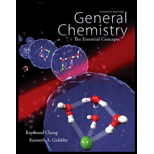
Interpretation: Basic feature of galvanic cell and the separated component should be briefly described.
Concept Introduction:
Salt bridge: A salt bridge is an inverted U- tube that contains an electrolyte and connects the two half-cells in a galvanic cell.
OR
A tube containing an electrolyte, providing electrical contact between two solutions.
OR
A link between electrically charged acidic and basic groups, especially on different parts of a large molecule such as a protein.
Electrolyte:
An electrolyte is a compound which forms ions when dissolved in an aqueous solution.
Electrolyte may be acid base and salts. The most common electrolyte used is calcium, chloride, magnesium, etc.
Anode: Where oxidation occurs, gives off electrons.
Cathode: Where the reduction take place.
Cell voltage: The voltage experienced across the electrodes of a galvanic cell.
Electromotive force: It is the special kind of force which can measure the voltage.
Standard reduction potential: The voltages associate with the reduction reaction at an electrode when all solute are 1M and all gases are at 1atm.
The purpose of salt bridge is not to move electrons from the electrolyte; rather it’s to maintain charge balance because the electrons are moving from one half cell to the other.
The electron flow from anode to cathode.
Some example of galvanic cell are given below,
1) Concentration cell
2) Galvanic cell
Want to see the full answer?
Check out a sample textbook solution
Chapter 19 Solutions
Package: General Chemistry with Connect 2-year Access Card
 ChemistryChemistryISBN:9781305957404Author:Steven S. Zumdahl, Susan A. Zumdahl, Donald J. DeCostePublisher:Cengage Learning
ChemistryChemistryISBN:9781305957404Author:Steven S. Zumdahl, Susan A. Zumdahl, Donald J. DeCostePublisher:Cengage Learning ChemistryChemistryISBN:9781259911156Author:Raymond Chang Dr., Jason Overby ProfessorPublisher:McGraw-Hill Education
ChemistryChemistryISBN:9781259911156Author:Raymond Chang Dr., Jason Overby ProfessorPublisher:McGraw-Hill Education Principles of Instrumental AnalysisChemistryISBN:9781305577213Author:Douglas A. Skoog, F. James Holler, Stanley R. CrouchPublisher:Cengage Learning
Principles of Instrumental AnalysisChemistryISBN:9781305577213Author:Douglas A. Skoog, F. James Holler, Stanley R. CrouchPublisher:Cengage Learning Organic ChemistryChemistryISBN:9780078021558Author:Janice Gorzynski Smith Dr.Publisher:McGraw-Hill Education
Organic ChemistryChemistryISBN:9780078021558Author:Janice Gorzynski Smith Dr.Publisher:McGraw-Hill Education Chemistry: Principles and ReactionsChemistryISBN:9781305079373Author:William L. Masterton, Cecile N. HurleyPublisher:Cengage Learning
Chemistry: Principles and ReactionsChemistryISBN:9781305079373Author:William L. Masterton, Cecile N. HurleyPublisher:Cengage Learning Elementary Principles of Chemical Processes, Bind...ChemistryISBN:9781118431221Author:Richard M. Felder, Ronald W. Rousseau, Lisa G. BullardPublisher:WILEY
Elementary Principles of Chemical Processes, Bind...ChemistryISBN:9781118431221Author:Richard M. Felder, Ronald W. Rousseau, Lisa G. BullardPublisher:WILEY





